Impact of Water Temperature on Heart Rate Variability during Bathing
Abstract
1. Introduction
1.1. HRV and Stress
1.2. HRV and Gender and Age
1.3. HRV and Disease
1.4. HRV and Sleep
1.5. HRV and Other Factors
2. Method
2.1. ECG Collection System
2.2. Subjects and ECG Recordings
2.3. ECG Processing
2.4. HRV Analysis
2.5. Statistical Analysis of the HRV Features
3. Results
4. Discussion
5. Conclusions and Future Work
Author Contributions
Funding
Institutional Review Board Statement
Informed Consent Statement
Data Availability Statement
Acknowledgments
Conflicts of Interest
References
- Saul, J.P. Beat-to-beat variations of heart rate reflect modulation of cardiac autonomic outflow. Physiology 1990, 5, 32–37. [Google Scholar] [CrossRef]
- Van Praag, H. Crossroads of corticotropin releasing hormone, corticosteroids and monoamines. Neurotox. Res. 2002, 4, 531–556. [Google Scholar] [CrossRef]
- Hjortskov, N.; Rissén, D.; Blangsted, A.K.; Fallentin, N.; Lundberg, U.; Søgaard, K. The effect of mental stress on heart rate variability and blood pressure during computer work. Eur. J. Appl. Physiol. 2004, 92, 84–89. [Google Scholar] [CrossRef]
- Kofman, O.; Meiran, N.; Greenberg, E.; Balas, M.; Cohen, H. Enhanced performance on executive functions associated with examination stress: Evidence from task-switching and Stroop paradigms. Cogn. Emot. 2006, 20, 577–595. [Google Scholar] [CrossRef]
- Vuksanović, V.; Gal, V. Heart rate variability in mental stress aloud. Med. Eng. Phys. 2007, 29, 344–349. [Google Scholar] [CrossRef]
- Li, Z.; Snieder, H.; Su, S.; Ding, X.; Thayer, J.F.; Treiber, F.A.; Wang, X. A longitudinal study in youth of heart rate variability at rest and in response to stress. Int. J. Psychophysiol. 2009, 73, 212–217. [Google Scholar] [CrossRef]
- Schubert, C.; Lambertz, M.; Nelesen, R.; Bardwell, W.; Choi, J.B.; Dimsdale, J. Effects of stress on heart rate complexity—A comparison between short-term and chronic stress. Biol. Psychol. 2009, 80, 325–332. [Google Scholar] [CrossRef]
- Tharion, E.; Parthasarathy, S.; Neelakantan, N. Short-term heart rate variability measures in students during examinations. Natl. Med. J. India 2009, 22, 63–66. [Google Scholar]
- Lackner, H.K.; Papousek, I.; Batzel, J.J.; Roessler, A.; Scharfetter, H.; Hinghofer-Szalkay, H. Phase synchronization of hemodynamic variables and respiration during mental challenge. Int. J. Psychophysiol. 2011, 79, 401–409. [Google Scholar] [CrossRef]
- Taelman, J.; Vandeput, S.; Vlemincx, E.; Spaepen, A.; Van Huffel, S. Instantaneous changes in heart rate regulation due to mental load in simulated office work. Eur. J. Appl. Physiol. 2011, 111, 1497–1505. [Google Scholar] [CrossRef]
- Traina, M.; Cataldo, A.; Galullo, F.; Russo, G. Heart rate variability in healthy subjects. Minerva Psichiatr. 2011, 52, 227–231. [Google Scholar]
- Visnovcova, Z.; Mestanik, M.; Javorka, M.; Mokra, D.; Gala, M.; Jurko, A.; Calkovska, A.; Tonhajzerova, I. Complexity and time asymmetry of heart rate variability are altered in acute mental stress. Physiol. Meas. 2014, 35, 1319. [Google Scholar] [CrossRef]
- González-Camarena, R.; Carrasco-Sosa, S.; Román-Ramos, R.; Gaitán-González, M.J.; Medina-Bañuelos, V.; Azpiroz-Leehan, J. Effect of static and dynamic exercise on heart rate and blood pressure variabilities. Med. Sci. Sport. Exerc. 2000, 32, 1719–1728. [Google Scholar] [CrossRef] [PubMed]
- Salahuddin, L.; Cho, J.; Jeong, M.G.; Kim, D. Ultra short term analysis of heart rate variability for monitoring mental stress in mobile settings. In Proceedings of the 2007 29th Annual International Conference of the IEEE Engineering in Medicine and Biology Society, Lyon, France, 22–26 August 2007; pp. 4656–4659. [Google Scholar]
- Costin, R.; Rotariu, C.; Pasarica, A. Mental stress detection using heart rate variability and morphologic variability of EeG signals. In Proceedings of the 2012 International Conference and Exposition on Electrical and Power Engineering, New York, NY, USA, 25–27 October 2012; pp. 591–596. [Google Scholar]
- Ruediger, H.; Seibt, R.; Scheuch, K.; Krause, M.; Alam, S. Sympathetic and parasympathetic activation in heart rate variability in male hypertensive patients under mental stress. J. Hum. Hypertens. 2004, 18, 307–315. [Google Scholar] [CrossRef] [PubMed]
- Owen, N.; Steptoe, A. Natural killer cell and proinflammatory cytokine responses to mental stress: Associations with heart rate and heart rate variability. Biol. Psychol. 2003, 63, 101–115. [Google Scholar] [CrossRef]
- Custodis, F.; Gertz, K.; Balkaya, M.; Prinz, V.; Mathar, I.; Stamm, C.; Kronenberg, G.; Kazakov, A.; Freichel, M.; Böhm, M.; et al. Heart rate contributes to the vascular effects of chronic mental stress: Effects on endothelial function and ischemic brain injury in mice. Stroke 2011, 42, 1742–1749. [Google Scholar] [CrossRef]
- Jouven, X.; Schwartz, P.J.; Escolano, S.; Straczek, C.; Tafflet, M.; Desnos, M.; Empana, J.P.; Ducimetière, P. Excessive heart rate increase during mild mental stress in preparation for exercise predicts sudden death in the general population. Eur. Heart J. 2009, 30, 1703–1710. [Google Scholar] [CrossRef][Green Version]
- Yadav, A.; Awasthi, N.; Gaur, K.; Yadav, K. Comparison of Heart Rate Variability during Physical and Mental Stress in Type ’A’ and Type ’B’ personality: An Interventional Study. Int. Multispecialty J. Health (IMJH) 2019, 5, 133–140. [Google Scholar]
- Papousek, I.; Nauschnegg, K.; Paechter, M.; Lackner, H.K.; Goswami, N.; Schulter, G. Trait and state positive affect and cardiovascular recovery from experimental academic stress. Biol. Psychol. 2010, 83, 108–115. [Google Scholar] [CrossRef]
- Melzig, C.A.; Weike, A.I.; Hamm, A.O.; Thayer, J.F. Individual differences in fear-potentiated startle as a function of resting heart rate variability: Implications for panic disorder. Int. J. Psychophysiol. 2009, 71, 109–117. [Google Scholar] [CrossRef]
- Hauschildt, M.; Peters, M.J.; Moritz, S.; Jelinek, L. Heart rate variability in response to affective scenes in posttraumatic stress disorder. Biol. Psychol. 2011, 88, 215–222. [Google Scholar] [CrossRef] [PubMed]
- Lakusic, N.; Fuckar, K.; Mahovic, D.; Cerovec, D.; Majsec, M.; Stancin, N. Characteristics of heart rate variability in war veterans with post-traumatic stress disorder after myocardial infarction. Mil. Med. 2007, 172, 1190–1193. [Google Scholar] [CrossRef] [PubMed][Green Version]
- Guédon-Moreau, L.; Ducrocq, F.; Molenda, S.; Duhem, S.; Salleron, J.; Chaudieu, I.; Bert, D.; Libersa, C.; Vaiva, G. Temporal analysis of heart rate variability as a predictor of post traumatic stress disorder in road traffic accidents survivors. J. Psychiatr. Res. 2012, 46, 790–796. [Google Scholar]
- Alvares, G.A.; Quintana, D.S.; Kemp, A.H.; Van Zwieten, A.; Balleine, B.W.; Hickie, I.B.; Guastella, A.J. Reduced heart rate variability in social anxiety disorder: Associations with gender and symptom severity. PLoS ONE 2013, 8, e70468. [Google Scholar] [CrossRef]
- Martens, E.; Nyklicek, I.; Szabo, B.; Kupper, N. Depression and anxiety as predictors of heart rate variability after myocardial infarction. Psychol. Med. 2008, 38, 375–383. [Google Scholar] [CrossRef]
- Paritala, S.A. Effects of Physical and Mental Tasks on Heart Rate Variability; Louisiana State University: Baton Rouge, LA, USA, 2009; Volume 3928, pp. 1–85. [Google Scholar]
- Melillo, P.; De Luca, N.; Bracale, M.; Pecchia, L. Classification tree for risk assessment in patients suffering from congestive heart failure via long-term heart rate variability. IEEE J. Biomed. Health Inform. 2013, 17, 727–733. [Google Scholar] [CrossRef]
- Melillo, P.; Izzo, R.; De Luca, N.; Pecchia, L. Heart rate variability and target organ damage in hypertensive patients. BMC Cardiovasc. Disord. 2012, 12, 1–11. [Google Scholar] [CrossRef]
- Ramaekers, D.; Ector, H.; Aubert, A.; Rubens, A.; Van de Werf, F. Heart rate variability and heart rate in healthy volunteers. Is the female autonomic nervous system cardioprotective? Eur. Heart J. 1998, 19, 1334–1341. [Google Scholar] [CrossRef]
- Schwartz, J.B.; Gibb, W.J.; Tran, T. Aging effects on heart rate variation. J. Gerontol. 1991, 46, M99–M106. [Google Scholar] [CrossRef]
- Lochner, A.; Crooks, P.; Gordon Finlay, M.; Erwin, J.A.; Honn, K. Effect of Sleep Deprivation and Sleep Recovery on Heart Rate and Heart Rate Variability in Males Versus Females; Eastern Washington University: Cheney, WA, USA, 2020; Volume 40, pp. 1–2. [Google Scholar]
- Davy, K.P.; Desouza, C.A.; Jones, P.P.; Seals, D.R. Elevated heart rate variability in physically active young and older adult women. Clin. Sci. 1998, 94, 579–584. [Google Scholar] [CrossRef]
- Nagy, E.; Orvos, H.; Bárdos, G.; Molnár, P. Gender-related heart rate differences in human neonates. Pediatr. Res. 2000, 47, 778–780. [Google Scholar] [CrossRef]
- Bonnemeier, H.; Wiegand, U.K.; Brandes, A.; Kluge, N.; Katus, H.A.; Richardt, G.; Potratz, J. Circadian profile of cardiac autonomic nervous modulation in healthy subjects: Differing effects of aging and gender on heart rate variability. J. Cardiovasc. Electrophysiol. 2003, 14, 791–799. [Google Scholar] [CrossRef]
- Yamasaki, Y.; Kodama, M.; Matsuhisa, M.; Kishimoto, M.; Ozaki, H.; Tani, A.; Ueda, N.; Ishida, Y.; Kamada, T. Diurnal heart rate variability in healthy subjects: Effects of aging and sex difference. Am. J. Physiol.-Heart Circ. Physiol. 1996, 271, H303–H310. [Google Scholar] [CrossRef] [PubMed]
- Wilkowska, A.; Rynkiewicz, A.; Wdowczyk, J.; Landowski, J.; Cubała, W.J. Heart rate variability and incidence of depression during the first six months following first myocardial infarction. Neuropsychiatr. Dis. Treat. 2019, 15, 1951–1956. [Google Scholar] [CrossRef]
- Lutfi, M.F.; Sukkar, M.Y. Effect of blood pressure on heart rate variability. Khartoum. Med. J. 2011, 4, 548–553. [Google Scholar]
- Tombul, T.; Anlar, O.; Tuncer, M.; Huseyinoglu, N.; Eryonucu, B. Impaired heart rate variability as a marker of cardiovascular autonomic dysfunction in multiple sclerosis. Acta Neurol. Belg. 2011, 111, 116–120. [Google Scholar]
- Gurses, D.; Ulger, Z.; Levent, E.; Aydinok, Y.i.; Ozyurek, A.R. Time domain heart rate variability analysis in patients with thalassaemia major. Acta Cardiol. 2005, 60, 477–481. [Google Scholar] [CrossRef]
- Lan, M.Y.; Lee, G.S.; Shiao, A.S.; Ko, J.H.; Shu, C.H. Heart rate variability analysis in patients with allergic rhinitis. Sci. World J. 2013, 2013, 1–4. [Google Scholar] [CrossRef]
- DelRosso, L.M.; Mogavero, M.P.; Ferri, R. Effect of Sleep Disorders on Blood Pressure and Hypertension in Children. Curr. Hypertens. Rep. 2020, 22, 1–7. [Google Scholar] [CrossRef]
- Herzig, D.; Eser, P.; Omlin, X.; Riener, R.; Wilhelm, M.; Achermann, P. Reproducibility of heart rate variability is parameter and sleep stage dependent. Front. Physiol. 2018, 8, 1–10. [Google Scholar] [CrossRef]
- Padole, A.; Ingale, V.V. Investigating Effect of Sleep and Meditation on HRV and Classification using ANN. In Proceedings of the 2019 10th International Conference on Computing, Communication and Networking Technologies (ICCCNT), Kanpur, India, 6–8 July 2019; pp. 1–6. [Google Scholar]
- Arslan, M.; Welcome, M.O.; Dane, S. The Effect of Sleep Deprivation on Heart Rate Variability in Shift Nurses. J. Res. Med. Dent. Sci. 2019, 7, 45–52. [Google Scholar]
- Sűdy, Á.R.; Ella, K.; Bódizs, R.; Káldi, K. Association of social jetlag with sleep quality and autonomic cardiac control during sleep in young healthy men. Front. Neurosci. 2019, 13, 1–10. [Google Scholar] [CrossRef]
- Hynynen, E.; Vesterinen, V.; Rusko, H.; Nummela, A. Effects of moderate and heavy endurance exercise on nocturnal HRV. Int. J. Sports Med. 2010, 31, 428–432. [Google Scholar] [CrossRef]
- James, D.V.; Munson, S.C.; Maldonado-Martin, S.; De Ste Croix, M.B. Heart rate variability: Effect of exercise intensity on postexercise response. Res. Q. Exerc. Sport 2012, 83, 533–539. [Google Scholar] [CrossRef]
- Zuanetti, G.; Latini, R.; Neilson, J.M.; Schwartz, P.J.; Ewing, D.J.; Group, T.A.D.E. Heart rate variability in patients with ventricular arrhythmias: Effect of antiarrhythmic drugs. J. Am. Coll. Cardiol. 1991, 17, 604–612. [Google Scholar] [CrossRef]
- Murgia, F.; Melotti, R.; Foco, L.; Gögele, M.; Meraviglia, V.; Motta, B.; Steger, A.; Toifl, M.; Sinnecker, D.; Müller, A.; et al. Effects of smoking status, history and intensity on heart rate variability in the general population: The CHRIS study. PLoS ONE 2019, 14, e0215053. [Google Scholar] [CrossRef]
- Young, H.A.; Cousins, A.L.; Watkins, H.T.; Benton, D. Is the link between depressed mood and heart rate variability explained by disinhibited eating and diet? Biol. Psychol. 2017, 123, 94–102. [Google Scholar] [CrossRef]
- Latha, R.; Srikanth, S.; Sairaman, H.; Dity, N.R.E. Effect of music on heart rate variability and stress in medical students. Int. J. Clin. Exp. Physiol. 2014, 1, 131–134. [Google Scholar] [CrossRef]
- Sollers, J.J.; Sanford, T.A.; Nabors-Oberg, R.; Anderson, C.A.; Thayer, J.F. Examining changes in HRV in response to varying ambient temperature. IEEE Eng. Med. Biol. Mag. 2002, 21, 30–34. [Google Scholar] [CrossRef] [PubMed]
- Shin, H. Ambient temperature effect on pulse rate variability as an alternative to heart rate variability in young adult. J. Clin. Monit. Comput. 2016, 30, 939–948. [Google Scholar] [CrossRef]
- Mourot, L.; Bouhaddi, M.; Gandelin, E.; Cappelle, S.; Dumoulin, G.; Wolf, J.P.; Rouillon, J.D.; Regnard, J. Cardiovascular autonomic control during short-term thermoneutral and cool head-out immersion. Aviat. Space Environ. Med. 2008, 79, 14–20. [Google Scholar] [CrossRef]
- Choo, H.C.; Nosaka, K.; J Peiffer, J.; Ihsan, M.; C Yeo, C.; R Abbiss, C. Effect of water immersion temperature on heart rate variability following exercise in the heat. Kinesiology 2018, 50, 67–74. [Google Scholar]
- Kataoka, Y.; Yoshida, F. The change of hemodynamics and heart rate variability on bathing by the gap of water temperature. Biomed. Pharmacother. 2005, 59, S92–S99. [Google Scholar] [CrossRef]
- Edelhäuser, F.; Goebel, S.; Scheffer, C.; Cysarz, D. P02. 181. Heart rate variability and peripheral temperature during whole body immersion at different water temperatures. BMC Complement. Altern. Med. 2012, 12, 1. [Google Scholar] [CrossRef][Green Version]
- Xu, J.; Cui, P.; Chen, W. ECG-based Identity Validation during Bathing in Different Water Temperature. In Proceedings of the 2020 42nd Annual International Conference of the IEEE Engineering in Medicine & Biology Society (EMBC), Montreal, QC, Canada, 20–24 July 2020; pp. 5276–5279. [Google Scholar]
- Gupta, G.; Mehra, R. Design analysis of IIR filter for power line interference reduction in ECG signals. Int. J. Eng. Res. Appl. 2013, 3, 1309–1316. [Google Scholar]
- Wang, W.; Su, C. Ccbrsn: A system with high embedding capacity for covert communication in bitcoin. In IFIP Advances in Information and Communication Technology, Proceedings of the IFIP International Conference on ICT Systems Security and Privacy Protection, Maribor, Slovenia, 21–23 September 2020; Springer: Cham, Switzerland, 2020; pp. 324–337. [Google Scholar]
- Wang, W.; Huang, H.; Zhang, L.; Su, C. Secure and efficient mutual authentication protocol for smart grid under blockchain. Peer-to-Peer Netw. Appl. 2020, 1–13. [Google Scholar] [CrossRef]
- Zhang, L.; Zhang, Z.; Wang, W.; Jin, Z.; Su, Y.; Chen, H. Research on a Covert Communication Model Realized by Using Smart Contracts in Blockchain Environment. IEEE Syst. J. 2021, 15, 1–12. [Google Scholar]
- Zhang, L.; Zou, Y.; Wang, W.; Jin, Z.; Su, Y.; Chen, H. Resource allocation and trust computing for blockchain-enabled edge computing system. Comput. Secur. 2021, 105, 102249. [Google Scholar] [CrossRef]
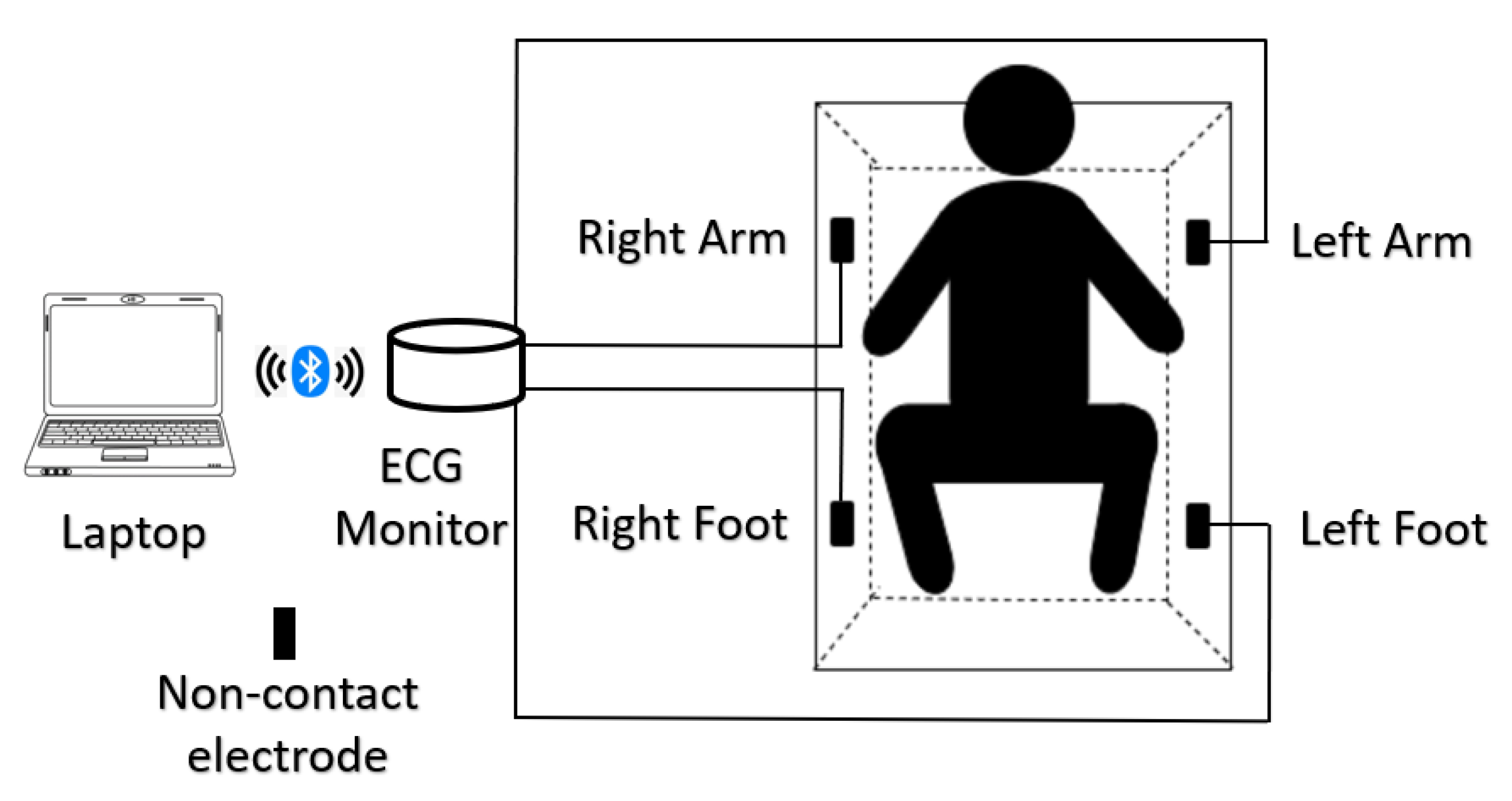
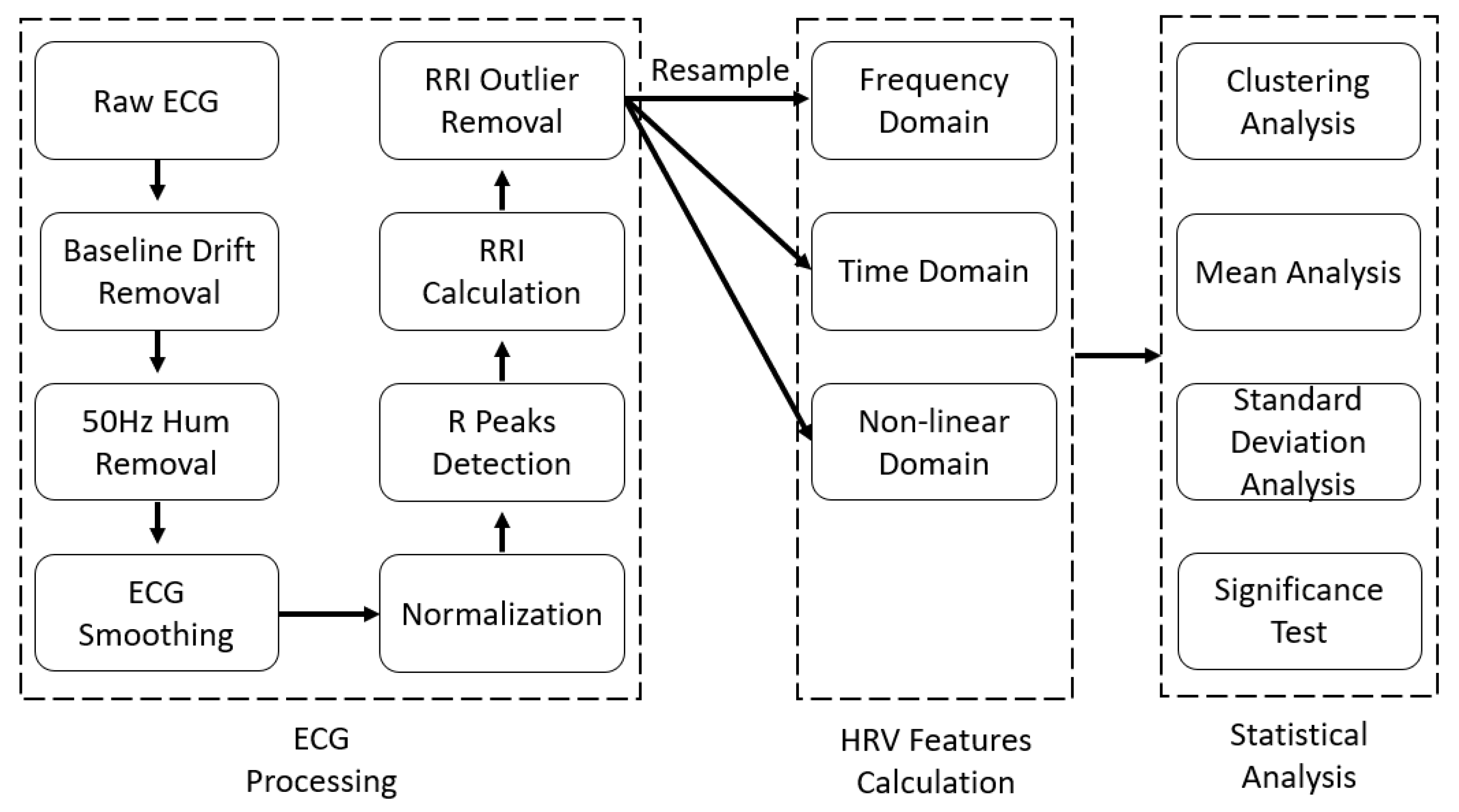

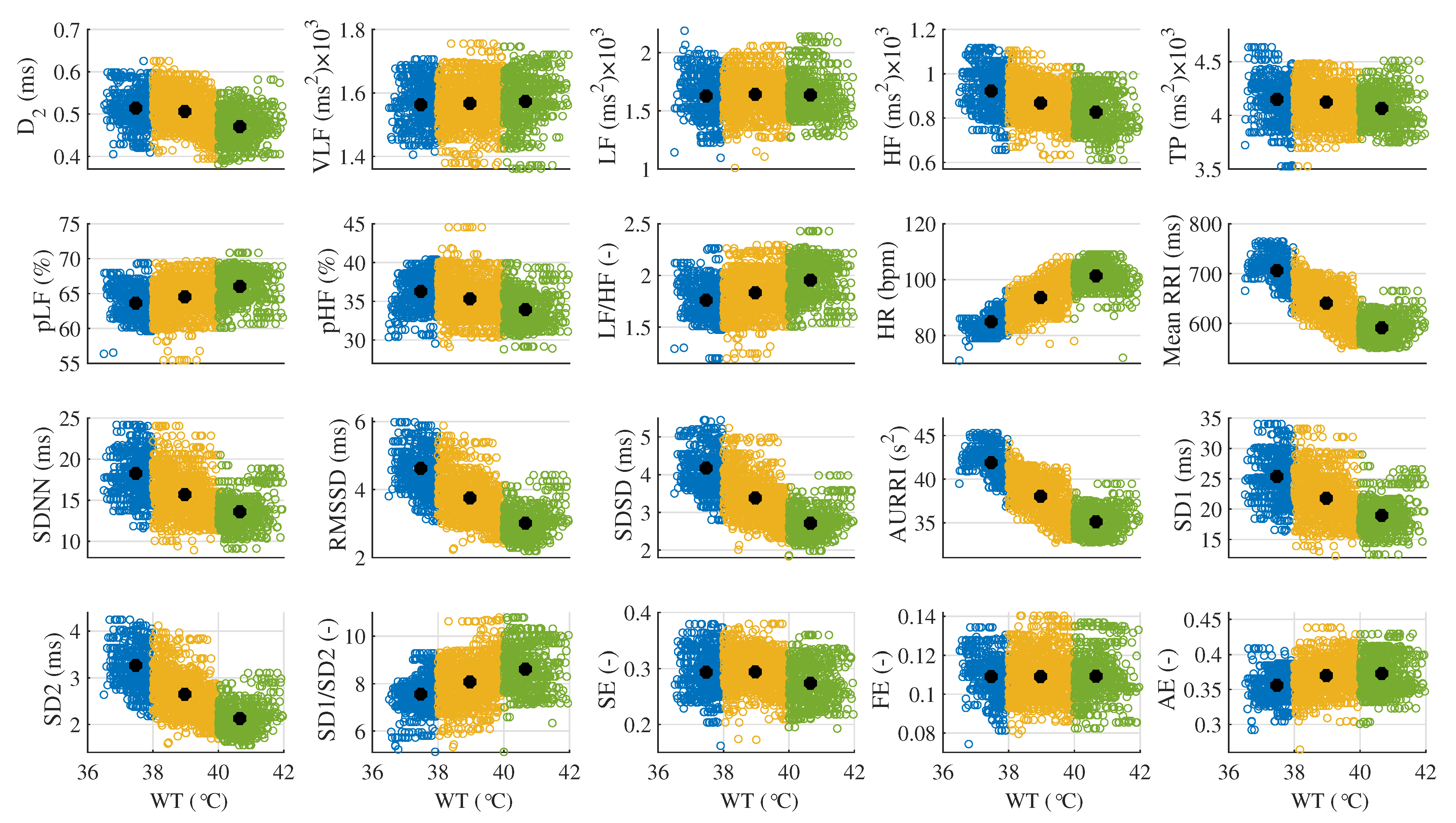
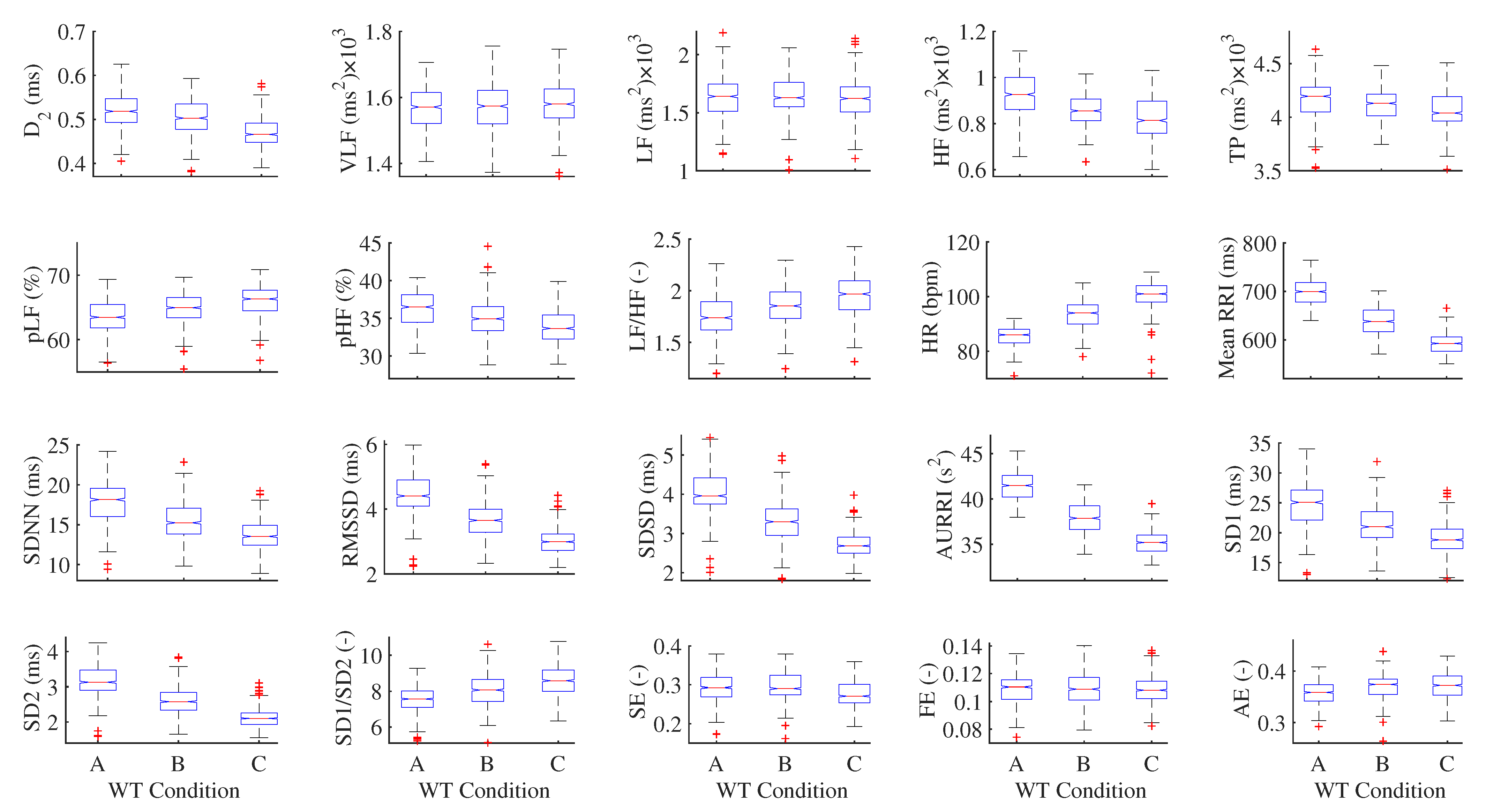
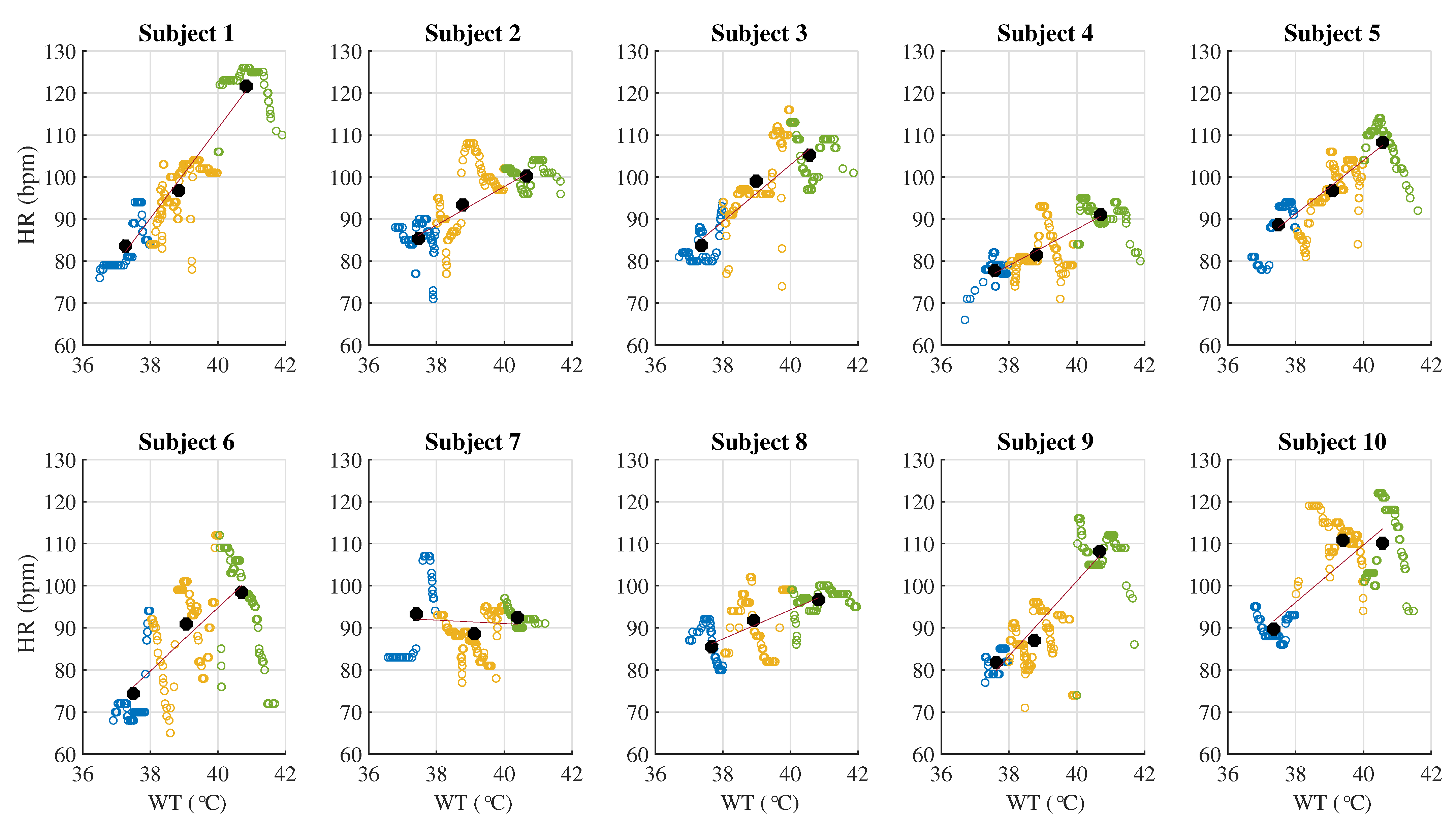
| HRV Features | Features | (36 38] °C | (38 40] °C | (40 42] °C | p Value | ||||||
|---|---|---|---|---|---|---|---|---|---|---|---|
| Trend | Mean | SD | Mean | SD | Mean | SD | p1 | p2 | p3 | ||
| Time | HR (bpm) | ↑↑ | 85.55 | 3.38 | 94.07 | 4.65 | 101.30 | 4.17 | 0 | 0 | 0 |
| Domain | Mean RRI (ms) | ↓↓ | 699.93 | 27.53 | 637.04 | 30.67 | 591.15 | 22.42 | 0 | 0 | 0 |
| SDNN (ms) | ↓↓ | 17.99 | 2.94 | 15.48 | 2.48 | 13.70 | 1.87 | 0 | 0 | 0 | |
| RMSSD (ms) | ↓↓ | 4.54 | 0.74 | 3.69 | 0.57 | 3.03 | 0.42 | 0 | 0 | 0 | |
| SDSD (ms) | ↓↓ | 4.11 | 0.65 | 3.32 | 0.50 | 2.72 | 0.35 | 0 | 0 | 0 | |
| AURRI (s) | ↓↓ | 41.51 | 1.62 | 37.82 | 1.80 | 35.12 | 1.32 | 0 | 0 | 0 | |
| Frequency | VLF Power (ms) | ↑ | 1561.77 | 78.82 | 1567.90 | 87.13 | 1573.03 | 80.22 | 0.07 | 0.14 | 0 |
| Domain | LF Power (ms) | ∧ | 1631.05 | 182.50 | 1646.35 | 159.13 | 1633.92 | 175.79 | 0.04 | 0.11 | 0.74 |
| HF Power (ms) | ↓↓ | 922.03 | 97.45 | 859.79 | 68.12 | 826.23 | 86.79 | 0 | 0 | 0 | |
| Total Power (ms) | ↓↓ | 4157.74 | 199.76 | 4114.04 | 158.49 | 4065.92 | 159.75 | 0 | 0 | 0 | |
| pLF (%) | ↑↑ | 63.53 | 2.37 | 64.75 | 2.58 | 65.91 | 2.29 | 0 | 0 | 0 | |
| pHF (%) | ↓↓ | 36.36 | 2.37 | 35.13 | 2.45 | 33.97 | 2.20 | 0 | 0 | 0 | |
| LF/HF (-) | ↑↑ | 1.75 | 0.18 | 1.85 | 0.20 | 1.95 | 0.19 | 0 | 0 | 0 | |
| Non-linear | D (ms) | ↓↓ | 0.52 | 0.04 | 0.51 | 0.04 | 0.47 | 0.04 | 0 | 0 | 0 |
| Domain | SD1 (ms) | ↓↓ | 24.94 | 4.10 | 21.51 | 3.48 | 19.11 | 2.62 | 0 | 0 | 0 |
| SD2 (ms) | ↓↓ | 3.21 | 0.53 | 2.61 | 0.40 | 2.14 | 0.30 | 0 | 0 | 0 | |
| SD1/SD2 (-) | ↑↑ | 7.63 | 0.82 | 8.03 | 0.86 | 8.65 | 0.85 | 0 | 0 | 0 | |
| SE (-) | ∧ | 0.29 | 0.04 | 0.30 | 0.03 | 0.27 | 0.03 | 0.15 | 0 | 0 | |
| FE (-) | ∼ | 0.11 | 0.01 | 0.11 | 0.01 | 0.11 | 0.01 | 0.21 | 0.04 | 0.43 | |
| AE (-) | ∼ | 0.36 | 0.02 | 0.37 | 0.02 | 0.37 | 0.02 | 0 | 0.14 | 0 | |
| Subject | 1 | 2 | 3 | 4 | 5 | 6 | 7 | 8 | 9 | 10 |
| Slope | 10.71 | 4.59 | 6.72 | 4.34 | 6.36 | 7.48 | −0.41 | 3.46 | 8.91 | 6.83 |
Publisher’s Note: MDPI stays neutral with regard to jurisdictional claims in published maps and institutional affiliations. |
© 2021 by the authors. Licensee MDPI, Basel, Switzerland. This article is an open access article distributed under the terms and conditions of the Creative Commons Attribution (CC BY) license (https://creativecommons.org/licenses/by/4.0/).
Share and Cite
Xu, J.; Chen, W. Impact of Water Temperature on Heart Rate Variability during Bathing. Life 2021, 11, 378. https://doi.org/10.3390/life11050378
Xu J, Chen W. Impact of Water Temperature on Heart Rate Variability during Bathing. Life. 2021; 11(5):378. https://doi.org/10.3390/life11050378
Chicago/Turabian StyleXu, Jianbo, and Wenxi Chen. 2021. "Impact of Water Temperature on Heart Rate Variability during Bathing" Life 11, no. 5: 378. https://doi.org/10.3390/life11050378
APA StyleXu, J., & Chen, W. (2021). Impact of Water Temperature on Heart Rate Variability during Bathing. Life, 11(5), 378. https://doi.org/10.3390/life11050378







